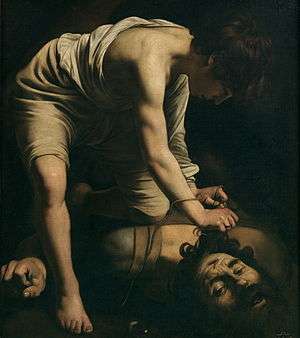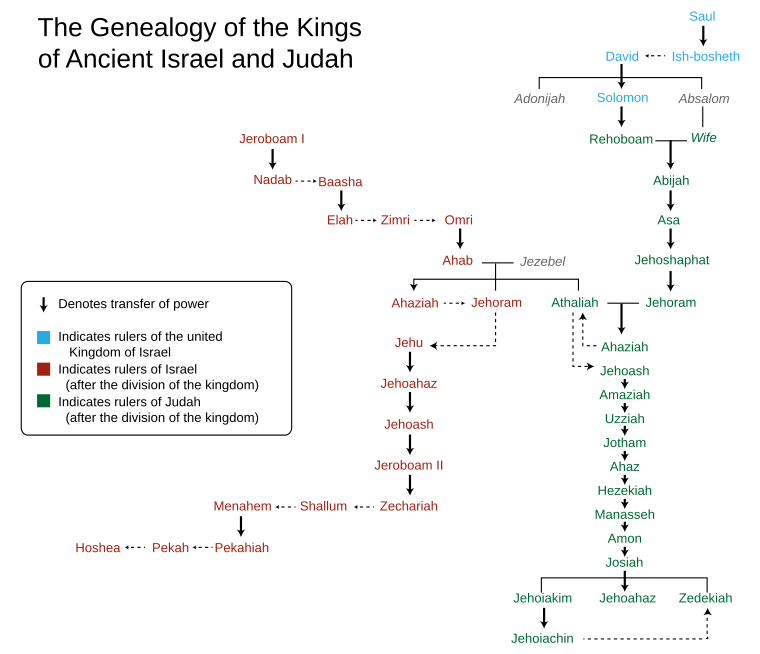Davidic line
| House of David | |
|---|---|
 | |
| Country |
Israel Judah |
| Parent house | Tribe of Judah |
| Titles |
King of Israel King of Judah |
| Founder | David of Judah |
| Final ruler | Zedekiah of Judah |
The Davidic line (also referred to as the House of David) (known in Hebrew as Malkhut Beit David (מלכות בית דוד) – "Kingdom of the House of David") refers to the tracing of lineage to King David referred to many times in the Hebrew Bible and in the New Testament. [1]
History
| Rulers of Judah |
|---|
According to the Tanakh upon being chosen and becoming king, the custom was anointing with Holy Oil poured on the head. In David's case, this was done by the prophet Samuel[2]

In Hebrew, the anointing is called meshicha (meaning "pulling") and a king (melekh or melech in Hebrew) is referred to as a Moshiach or Messiah or a Melech HaMashiach meaning "the anointed king". The procedure of anointment, in David's case, is said to symbolize the descent of God's holiness (kedusha) upon the king and as a sign of a bond never to be broken.
Initially, David was king over the Tribe of Judah only and ruled from Hebron, but after seven and a half years, the other Israelite tribes, who found themselves leaderless after the death of Ish-bosheth chose him to be their king as well[3]
All subsequent kings in both the ancient first united Kingdom of Israel and the later Kingdom of Judah claimed direct descent from King David to validate their claim to the throne in order to rule over the Israelite tribes.
After the death of David's son, King Solomon, the ten northern tribes of the Kingdom of Israel rejected the Davidic line, refusing to accept Solomon's son, Rehoboam, and instead chose as king Jeroboam and formed the northern Kingdom of Israel. This kingdom was eventually conquered by Assyria who exiled them, to disappear from history as The Ten Lost Tribes.

The Exilarch
Following the conquest of Judah by Babylon and the exile of its population, the Babylonian Exilarchate was established. The highest official of Babylonian Jewry was the exilarch (Reish Galuta, "Head of the Diaspora"). Those who held the position traced their ancestry to the House of David in the male line.[4] The position holder was regarded as a king-in-waiting.
Hasmonean monarchy
The Hasmoneans, also known as the Maccabees, were a priestly group (kohanim) from the Tribe of Levi. They established their own monarchy in Judea following their revolt against the Hellenistic Seleucid dynasty. The Hasmoneans were not considered connected to the Davidic line nor to the Tribe of Judah. The Levites had always been excluded from the Israelite monarchy, so when the Maccabees assumed the throne in order to rededicate the defiled Second Temple, a cardinal rule was broken. According to scholars within Orthodox Judaism, this is considered to have contributed to their downfall and the eventual downfall of Judea; internal strife allowing for Roman occupation and the violent installation of Herod the Great as client king over the Roman province of Judea; and the subsequent destruction of the Second Temple by the Emperor Titus.
Jewish interpretations
In Jewish eschatology, the term mashiach, or "Messiah", came to refer to a future Jewish King from the Davidic line, who is expected to be anointed with holy anointing oil and rule the Jewish people during the Messianic Age.[5][6][7] The Messiah is often referred to as "King Messiah", or, in Hebrew, מלך משיח (melekh mashiach), and, in Aramaic, malka meshiḥa.[8]
Orthodox views have generally held that the Messiah will be descended from his father through the line of King David,[9] and will gather the Jews back into the Land of Israel, usher in an era of peace, build the Third Temple, father a male heir, re-institute the Sanhedrin, and so on. Jewish tradition alludes to two redeemers, both of whom are called mashiach and are involved in ushering in the Messianic age: Mashiach ben David; and Mashiach ben Yosef. In general, the term Messiah unqualified refers to Mashiach ben David (Messiah, son of David).[5][6]
Christian interpretations
In Christian interpretation the "Davidic promise" of a Davidic line in 2 Samuel 7 is understood in various ways, traditionally referring to the genealogies of Christ in the New Testament. One Christian interpretation of the Davidic line counts the line continuing to Jesus of Nazareth via adoption of Joseph of Nazareth, according to the family tree of the kings of Judah in Gospel of Matthew chapter 1 (the later part of which is not recorded in the Hebrew Bible). Another Christian interpretation emphasizes the minor, non-royal, line of David through Solomon's brother Nathan as recorded in Gospel of Luke chapter 3 (entirely undocumented in the Hebrew Bible), which is often understood to be the family tree of Mary's father. A widely spread traditional Christian interpretation relates the non-continuation of the main Davidic line from Solomon as related the godlessness of Jehoiachin in the early 500s BC, where Jeremiah cursed the main branch of the Solomonic line, saying that no descendant of "[Je]Coniah" would ever again reign on the throne of Israel (Jer. 22:30).[10] This same "curse" is also considered by some Christian commentators as the reason that Zerubbabel, the rightful Solomonic king during the time of Nehemiah, was not given a kingship under the Persian empire.[11]
David the Prince
In Mormon eschatology, Latter-Day Saints express in the belief of a Davidic prophet by the name of David who would come in the last days to prepare for the Second Coming of the Lord including the building of the Third Jewish Temple.[12]
House of David in Islam
The Quran mentioned the house of David once {Work, O family of David, in gratitude. And few of My servants are grateful.}[13] and mentioned David 16 times.
See also
- Exilarch
- Origin of the Bagratid dynasties
- Claim of the biblical descent of the Bagrationi dynasty
- Solomonic dynasty
- Kebra Nagast
- History of ancient Israel and Judah
- LMLK seal
- Jewish eschatology
- Messiah
- Jesus
- Principles of Faith: The Messianic Age
- Tree of life (biblical)
- British Israelism
References
- ↑ Examples can be found in: 1 Kings 12:201 Kings 12:26 1 Kings 13:2, 1 Kings 14:8,2 Kings 12:1–19,2 Kings 17:21,2 Samuel 3:1, 1 Samuel 19:11HE, 1 Samuel 20:16,2 Samuel 3:6,Isaiah 7:2,Jeremiah 21:12,Zechariah 12:7, Nehemiah 12:37, Psalms 30:1,Psalms 122:5, 1 Chronicles 17:24, 2 Chronicles 10:19, etc.
- ↑ King David: You are the Man!, D. Owen Kaiser, Dog Ear Publishing, 2011, pg 16
- ↑ Who's Who in the Jewish Bible, David Mandel, Jewish Publication Society, 1 Jan 2010, pg 85
- ↑ Max A Margolis and Alexander Marx, A History of the Jewish People (1927), p. 235.
- 1 2 Schochet, Jacob Immanuel. "Moshiach ben Yossef". Tutorial. Moshiach.com. Retrieved 2 December 2012.
- 1 2 Blidstein, Prof. Dr. Gerald J. "Messiah in Rabbinic Thought". MESSIAH. Jewish Virtual Library and Encyclopaedia Judaica 2008 The Gale Group. Retrieved 2 December 2012.
- ↑ Telushkin, Joseph (1991). "The Messiah". William Morrow and Co. Retrieved 2 December 2012.
- ↑ Flusser, David. "Second Temple Period". Messiah. Encyclopaedia Judaica 2008 The Gale Group. Retrieved 2 December 2012.
- ↑ See Rabbi Aryeh Kaplan: "The Real Messiah A Jewish Response to Missionaries" at the Wayback Machine (archived May 29, 2008)
- ↑ H. Wayne House Israel: Land and the People 1998 114 "And yet, Judah has also been without a king of the Solomonic line since the Babylonian exile. Because of Jeremiah's curse on Jehoiachin (Coniah) in the early 500s BC (Jer. 22:30), the high priests of Israel, while serving as the ..."
- ↑ Warren W. Wiersbe -The Wiersbe Bible Commentary: The Complete Old Testament - 2007 p1497 "Zerubbabel was the grandson of King Jehoiachin (Jeconiah, Matt. 1:12; Coniah, Jer. 22:24, 28), and therefore of the royal line of David. But instead of wearing a crown and sitting on a throne, Zerubbabel was the humble governor of a ..."
- ↑ 'David, Prophetic Figure of Last Days'
- ↑ Quran 34:13
- Sources
- The Holy Bible: 1611 Edition (Thos. Nelson, 1993)
External links
- Jewish Encyclopedia.com: "Exilarchs"
- A genealogy of the Exilarchs: "From Judah to Bustanai"
- Rabbinic Sources and Seder Olam Zuta: "Seder Olam Zuta" & "Rav-SIG"
- Davidic Dynasty, an organization that seeks to trace descent from King David: "Davidic Dynasty"